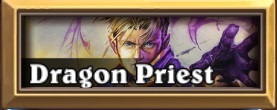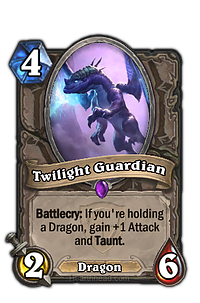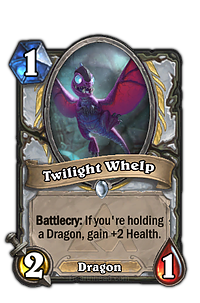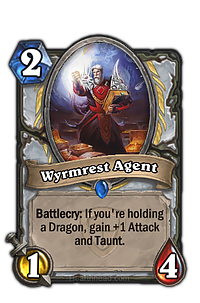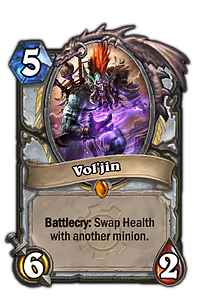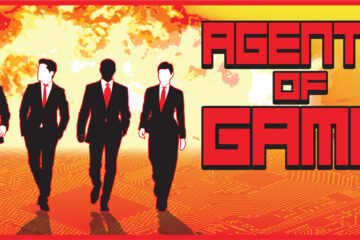Dragon Priest
One of the classes that benefited most from the Grand Tournament expansion was Priest. Priest has always been an underdog class, and before TGT there were basically only two versions, a standard big minion control version and the one featuring Deathlords. Neither were very competitive.
Thanks to some of the new cards from the expansion, there is enough synergy for players to bring a full dragon based deck to the table. Right now, Priest is the best equipped class to play a dragon heavy deck, thanks to some key class cards. This deck is also well equipped to handle the ranked ladder, with enough early game to fend off aggressive decks and enough late game to go against midrange decks as well.
This version is taken from the decklist that Cloud 9 brought to the Archon Team League Championship. There is one notable substitution: I only have one copy of Twilight Guardian right now, and the original list runs 2. I substituted a Twilight Drake, but if you have two Twilight Guardians, I suggest you use them.
The Basics
The first thing to note about dragon priest is that the deck relies heavily on board control. One of the priest class’s greatest weaknesses is that it does not have a strong burst combo to finish the game. This is unfortunately still true of dragon priest. So it’s important to mulligan for 1 or 2 mana cards and preferably a 4 mana dragon. That way, you can start off the game with lots of board presence and then as mana gets around 5, you can start using you hero power to make trades and heal your minions, extending your board control.
There are two low mana cards that are excellent at this and they are both Priest class cards. Twilight Whelp only costs 1 mana, and if you are holding another dragon in your hand (it is a dragon, so it will activate other dragon-dependent cards but not itself, similar to Twilight Guardian), this basic 2/1 becomes a 2/3. The only other 2/3 minion for 1 mana is Zombie Chow, and it was considered so strong that it had to heal your opponent for 5 health to balance it out. If you find a Twilight Whelp, keep it and mulligan the rest of your hand to get another dragon so you can activate it. It’s a very strong turn 1 play.
Next we have the Wyrmrest Agent. This card is very durable with 4 health, but when you have a dragon in your hand, it gets a buff, becoming a 2/4 with taunt. Again, this is a very strong 2 mana minion often able to trade 2 for 1, which is great against agro decks. Even if you don’t have a dragon to activate it, this card can still be useful in the early game. It still trades very well against 1 health minions and is an excellent target for healing with a Northshire Cleric to draw a card. So don’t be afraid to play this card on turn 2 even without a dragon.
Dragons
While there are some versions of this deck that load up with three or four 9 mana dragons, this deck takes a more balanced approach. For the midgame, there are several 4 and 5 mana dragons which are great for activating battlecries, but are also useful by themselves. Twilight Guardian is the star of the show. Similar to the Wyrmrest Agent, if you have another dragon in your hand, Twilight Guardian becomes a 3/6 minion with taunt. Compared to the previous gold standard for 4 mana taunters, the Sen’jin Shieldmasta, a 3/5 with taunt, you get 1 extra health point. That might not seem like a lot, but with a priest’s hero power, that 1 extra HP can easily become 3 or 5 more health, making this a very powerful minion.
Azure Drakes and a Dragonkin Sorcerer round out the midgame dragons. Azure Drake has always been a strong card, putting down a 4/4 body, drawing a card, and giving a bonus point of spell power. The Dragonkin Sorcerer is a bit of a technical choice, but it does have some amazing synergies in the deck. When you (not your opponent, just you) target the Sorcerer with a spell, it gains a +1/+1 buff. With both Powerword: Shield and Velen’s Chosen, there are a lot of chances to make the Sorcerer a huge threat if left unchecked.
The final dragon in this deck is Ysera. She is the heavy hitter out of your dragons and will often be your win condition. As an example, I played a control warrior that got some amazing card value from a Chromaggus that I couldn’t deal with right away. At least 5 cards got duplicated. I finally stabilized the board and got my Ysera down. His answer was Sylvanas, normally a terrible card to face down with this deck. However, since he couldn’t kill my Ysera, and with quite a bit of luck, I continually drew “Dream” cards and returned Sylvanas to his hand 4 times, allowing me to keep control of the board and easily win the match.
Tying it all Together
The key to winning with dragon priest is to maintain board control. Without a lucky string of “Ysera Awakens” cards to deal 5 damage to your opponent’s face, all the damage comes from minions. Be aggressive in the early game, and if you can’t put down a big threat on curve, look for a way to trade and use your hero power to keep your minions alive.
There are a lot of decisions to make during the course of a game as well. When to hold a dragon activated card and when to play it naked are key aspects to learn. Sometimes, a turn 5 Blackwing Corruptor for tempo is the correct play, even if you miss the potential 3 damage from his battlecry. Look at the cards you have in your hand and make the best decision based on that, rather than hoping for a lucky dragon card on your next turn.
Because Ysera is such an important card, do your best to bait out removal and silences before you play her. If you can get your opponent to waste these on Twilight Guardians or Velen’s Chosen buffed creatures, you are well on your way to winning the match.
I hope you enjoy giving dragon priest a try. It’s one of the truly original decks to come about since the TGT expansion and mastering it is very difficult. If there are other unique decks that you’ve seen since TGT came out, please let me know about them in the comments or on Twitter, @AGRitterific. I’m always on the lookout for cool decks to try!


